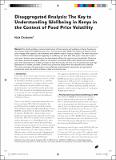| dc.contributor.author | Chisholm, Nick | en |
| dc.date.accessioned | 2016-01-11T13:54:36Z | |
| dc.date.available | 2016-01-11T13:54:36Z | |
| dc.date.issued | 01/11/2015 | en |
| dc.identifier.citation | Chisholm, N. (2015) Disaggregated Analysis: The Key to Understanding Wellbeing in Kenya in the Context of Food Price Volatility. IDS Bulletin 46(6): 33-44 | en |
| dc.identifier.issn | 1759-5436 | en |
| dc.identifier.uri | https://opendocs.ids.ac.uk/opendocs/handle/20.500.12413/7766 | |
| dc.description.abstract | This article provides a national?level picture of food security and wellbeing in Kenya, focusing on the situation before the 2008 food price crisis, and the period after 2008. The extent and impact of food price changes differ spatially, and households have different ways of trying to respond. The major food price shocks in 2008 and 2011 impacted negatively on wellbeing, but even after 2011 prices continued to rise in most areas. Seasonal price movements also have adverse effects for resource?poor households. Food price rises have a particularly negative impact on the poorest households. Urban slum dwellers are vulnerable given their dependence on market purchases to meet food needs, but most rural households also have high dependence on market purchases. Current social protection programmes are piecemeal and unreliable. The article concludes with proposals on more effective social protection approaches and agricultural programmes which can address problems linked to food price rises. | en |
| dc.format.extent | 12 | en |
| dc.relation.ispartofseries | IDS Bulletin Vol. 46 Nos. 6 | en |
| dc.rights.uri | http://www.ids.ac.uk/files/dmfile/IDSOpenDocsStandardTermsOfUse.pdf | en |
| dc.title | Disaggregated Analysis: The Key to Understanding Wellbeing in Kenya in the Context of Food Price Volatility | en |
| dc.type | Article | en |
| dc.identifier.doi | 10.1111/1759-5436.12184 | en |

